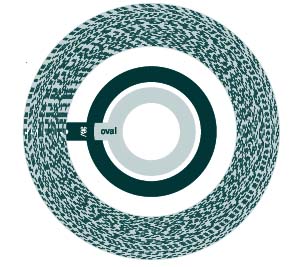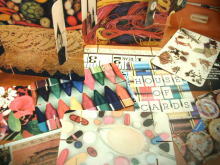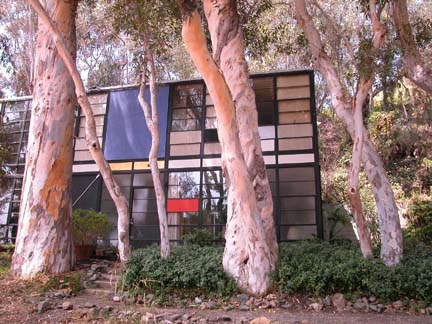PLAY/TIME
Blur project overview
-- continuation of interdisiplinary spaces
Glitch
def: a sudden irregularity or malfunction / glide, slide, slip,
Article begins with What people could not predict
-- recording and recombinant media would wrench human perceptions of time,
space, distance, nationality and locality into unrecognizable shapes
-- inherent qualities of the operating systems would inscribe themselves into
contentn interested in the technical errors and unplanned outcomes hidden in
music tracks – crackles, pops, gurgles, buzzes
-- the g.itch is only conceivable
in a world in which mucis is partly or wholly mechanized
WHY – recording makes sound an object subject to breakage -- an art that
'wrinkles time' -- the random factor , interrupts the flow of events
history: oval, Pan Sonic, Pole, underground digital music "where the glitch
currently resides"
author interested in -- creative potential of malfunctioning or mistreated equipment
method: damaged, scratched, harmed cds, esults sampled, then reorganized (collage)
sequencers
also a crack -- the product of cracked software
for example -- Metasynth -- (converts picture files to digital sound)

http://www.caipirinha.com/index.html
mixed media arts and culture
company with activities in fields of film, music and human rights
-- promote diversity, toilerance solidairty beyond borders as well as cross
collaboration between artforms
makers of film, electronic music, travelling mixed media installations -- architettura
(synergy of film + music = architecture)
waterloo station:
" Architecture is frozen music." (Madame de Stael)
-- always been an aesthetic connection between architecture
and music/sound.
-- Waterloo Terminal by Tetsu Inoue, inspired by the Channel Tunnel Terminal
at Waterloo Station in London.
- tetsu scanned over 1000 real and digitally altered photographs of the station into his computer and dumped them into his music software
listen: Waterloo Station
why important/interesting --

http://www.mnstate.edu/gracyk/courses/aesthetics%20of%20music/attali'snoise.htm
Attali: -- unmusical music was latently, inheretnly revolutionary "breach in social repetition and the control of noisemaking"
-- pleasure in the new instruments vs composers manipulating "limited harmonic means to enact narratives already ingrained in history and myth (as in opera)"
german composer bernhard Gunter : subjective time elapsing while listening to music, reding, studying -- passes differently from clock time
-- a new unit -- a dim
clicks -- digital fire crackling -- tidal, cyclical (like hypertext?)

Play – eames


"In the Eameses architecture, everything is a toy, everybody is a child"
Charles and Ray Eames: Click here for audio of Episode 814.
-- approach, methodology and style serve as inspiration because their work exemplified courage, education and play.
"the eamese liked to celebrate things. anything. everything. this is not just whimsy, a distraction from the work, but the work itself"
the house:

eames slides

-- photocollage method
-- Remaining open to change encourages wonder and perspective in the process of research and design.
-- Their playful and curious approach suggests living a journey of design research and exploration.
-- Traditionally, the role of designers is to translate information for a target audience using cultural signs and symbols
-- information exchange occurs at the intersection between the communication artifact and the audience's perception of its aesthetic makeup (i.e. the aesthetics of its design).
-- next week we will talk more about how this works
play theory:
Freud : , civilizations are built on our repressed desires.
We live lives of alienated "fulfillment," purchasing our identity along with a Gap sweater.
rel to consumerism
Marcuse : advanced industrial society creates false needs which integrated individuals into the existing system of production and consumption. Mass media and culture, advertising, industrial management, and contemporary modes of thought all reproduced the existing system and attempt to eliminate negativity, critique, and opposition. The result was a "one-dimensional" universe of thought and behavior in which the very aptitude and ability for critical thinking and oppositional behavior was withering away.
-- argued that other elements in Freud's theory suggested that the unconscious contained evidence of an instinctual drive toward happiness and freedom. This evidence is articulated, Marcuse suggests, in daydreams, works of art, philosophy, and other cultural products.
Max Horkheimer : art and philosophy (art and ideas) are expressions of freedom, and that the best hopes for a truly human life lie in these expressive forms of cultural life.
-
This liberating capacity appears because it is rooted in play, not labor.
- stands in opposition to labor, particularly the alienation and self-eradication
tedious work can produce.
- the play impulse, "a chance for unity of self."
Play, rooted in possibility, is an essential element needed for liberation and self-fulfillment. Play, fantasy, and imagination allow for a transcendence of the established order of things.
Art's potentially transcendental qualities, its expressiveness, creativeness, and imaginativeness allow for possibilities and a concept of life which exist in contradiction to contemporary society.
***********************************************
consider: -- the glitch and stutter, breaking musical narrative, the capacity to play, play as method, the liberatory potential of artistic expression
view: Eames film
questions:
How do the readings today fit with ideas of hypertext collage?
How does play fit with the Eames' concept of work?
In what ways are the philosophies of play we discussed today different from thoughts expressed by Eames? Similar?
Do you want to play more? What stops you/constrains you (if anything)? How does play fit with your own ideas about art/making art?
How does the glitch relate to time? How does play relate to time?
do you agree with the idea of 'subjective time' that passes differently from clock time? How might this relate to critiques of one-dimensionality? The idea of repression?